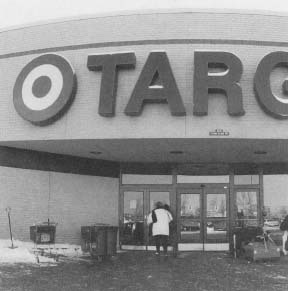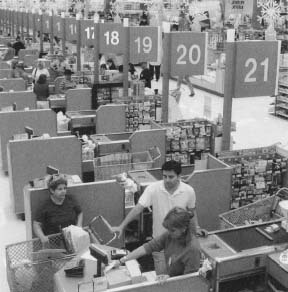Target Corporation
777 Nicollet Mall
Minneapolis, MN 55402
(612) 370-6948
www.targetcorp.com
For years, Wal-Mart Stores, Inc., and Kmart Corporation (see entries) dominated the discount retailing industry, offering low prices on a wide range of goods. Few people considered these companies or their smaller competitors trendy: shoppers came looking for bargains, not style. In recent years, however, Target has emerged as a different kind of discount store. Based in Minneapolis, Minnesota, Target offers goods that are higher in quality than its competitors, and its customers tend to be younger and wealthier than typical discount shoppers. Loyal Target customers even gave the store's name a French pronunciation—"Tarjay"—reflecting their belief that the store has more class than other stores.
Target was once just a small piece of the much larger Dayton Hudson Corporation, a retailer with roots in the late nineteenth century. In 2000, Dayton Hudson (DH) officials renamed the company, the Target Corporation. By doing so, they acknowledged the importance that discount retailing played in their corporate make-up. In the early twenty-first century, Target Corporation was building more Target stores and expanding into Internet commerce. It also attempted to strengthen its department store division, Marshall Field's.
The Glory Days of the Department Store
Marshall Field's, the last chain to join the former Dayton Hudson Corporation, is the oldest of the retail stores in today's Target Corporation. Massachusetts native Marshall Field settled in Chicago, Illinois, in 1856 and began working as a clerk in a dry-goods store. At the time, these store usually sold cloth, ready-made clothes, and small items. Within a few years, Field was a partner in the company. In 1867, he sold his share in that dry-goods firm to buy an interest in its largest competitor. In 1881, the store was renamed Marshall Field's, and it became Chicago's most prominent retailer.
That same year, J. L. Hudson (1846-1912) of Detroit, Michigan, opened his first store, selling boys' and men's clothing. As his business grew, Hudson added more products and built bigger stores, leading to his showcase Hudson's in downtown Detroit. Like other department stores, Hudson's offered a wide variety of quality merchandise. By the 1920s, Hudson's was the third-largest department store in the United States, behind Macy's of New York and Marshall Field's. Additions to the main store eventually made it the tallest department store in the country.
Target at a Glance
- Employees: 281,000
- CEO: Robert j. Ulrich
- Subsidiaries: Associated Merchandising Corporation; Bullseye Corporation; Capitol Lounge Corporation; Dayton Development Corporation; Dayton's Sioux Falls, Inc.; Eight Street Development Company; Marshall Field Stores, Inc.; Mervyn's, Inc.; Retail Properties, Inc.; Retailers National Bank, N. A.; Target Connect, Inc.; Target Services, Inc.; Target Stores, Inc.
- Major Competitors: Wal-Mart Stores, Inc.; Kmart Corporation; Sears, Roebuck & Company; May Department Stores; Federated Department Stores; j. C. Penney Company, Inc.; Kohl's Corporation; Dillard's Inc.; Saks, Inc.
- Notable Stores and Companies: Target; SuperTarget; Marshall Field's; Mervyn's; target.direct; Signals; Wireless; Seasons
In 1902, George Dayton (1857-1938) was the landlord of the Goodfellows dry-goods store in Minneapolis, Minnesota. The next year, the company hit hard times, and Dayton took over the business, renaming it the Dayton Dry Goods Company, then later shortening the name to the Dayton Company. Dayton's, Hudson's, and Marshall Field's were not direct competitors; they were regional stores that dominated their home cities and slowly spread out into the surrounding areas. But the stores did have local competition, and each tried to set high standards for service and merchandise. Each store also tried to offer customers unique touches. In its main store, Hudson's had five restaurants where customers could eat and relax. Marshall Field's was known for its Frango mints, chocolate candies sold nowhere else. In Minnesota, Dayton's stood for high fashion and community service. Starting in 1946, Dayton began donating 5 percent of its annual profits to local charities. This tradition continues today with the Target Corporation.
Timeline
- 1881:
- A Chicago department store owned by Marshall Field is given his name; J. L. Hudson opens his first store in Detroit, Michigan.
- 1903:
- George Draper Dayton takes control of a Minneapolis dry-goods store he renames Dayton's.
- 1946:
- The Dayton Company begins contributing 5 percent of its profits to local organizations.
- 1954:
- Hudson's opens the world's largest shopping center in suburban Detroit.
- 1956:
- Dayton's opens the world's first enclosed shopping malt in suburban Minneapolis.
- 1962:
- Dayton's opens the first Target discount store in Roseville, Minnesota.
- 1969:
- The). L Hudson Company and the Dayton Company merge, forming the Dayton Hudson Corporation.
- 1978:
- Dayton Hudson buys Mervyn's, a California chain.
- 1990:
- Dayton Hudson buys Marshall Field's.
- 2000:
- Reflecting the growth of its discount stores, Dayton Hudson changes its name to Target Corporation.
- 2001:
- Hudson's and Dayton's department stores are renamed Marshall Field's.
From Departments to Discounts
After World War II (1939-45), more Americans began living and working in the suburbs of cities such as Detroit, Chicago, and Minneapolis. Families still made trips to the big department stores, but Dayton's and Hudson's saw that to keep growing, they needed to expand beyond their downtown locations. In 1954, the J. L. Hudson Company built Northland Center, the world's largest shopping center at the time. Located in the Detroit suburb of Southfield, the center featured a Hudson's surrounded by other stores. Two years later, the Dayton Company opened Southdale, a two-story, enclosed suburban shopping mall—the first of its kind in the world.
The Dayton Company helped lead another major change in the retail industry. In 1962, it opened its first Target store in Roseville, Minnesota. Target was the first store to offer national, name-brand items at discount prices. Target, however, did not have this new market to itself for long; the same year, Wal-Mart and Kmart stores also opened. Those two competitors eventually became the leaders of the industry.
Discount stores, usually located in small towns and suburbs, began to challenge the strength of many urban department-store chains. To strengthen their position, the J. L. Hudson Company and the Dayton Company merged in 1969, forming the Dayton Hudson Corporation. The new company had several dozen department stores, most in Minnesota and Michigan, along with the growing Target chain.
The Hysteria over Hose
In February 1946, Dayton's was the scene of a frenzied moment in shopping history. The store held its first postwar sale on nylon stockings, which had been taken off the market during World War II (1939-45). The U.S. government needed the strong, stretchy material to make parachutes and other military supplies. At the Dayton's nylon sale, thirteen thousand shoppers jammed the streets of Minneapolis waiting for the store to open. They bought sixty thousand pairs of nylons in just one day.
Boom Years
During the 1970s and 1980s, DH grew dramatically. The company bought several other retailers, including Mervyn's, a California chain, B. Dalton Bookseller, and Lechmere, a regional chain based in the Northeast. DH chief executive officer (CEO) William Andres led the buying binge. The expansion continued when Kenneth A. Macke took control of the company in 1983. By then, company sales had passed $5 billion, and Target stores were the main source of that revenue. The following year, DH sold two smaller department store chains and decided to put even more money into its discount business. Also in 1984, DH merged Dayton's and Hudson's into one large department store division based in Minneapolis.
Department Store Pioneers
Joseph Lowthian Hudson (1846-1912) was a thirty-five-year old English immigrant when he opened his first store in 1881. George Draper Dayton (1857-1938) was a successful banker and landowner when he took over the Goodfellows store and renamed it Dayton's. Although they had different backgrounds, Hudson and Dayton shared the goals of providing excellent service and products to their customers.
Hudson came to the United States in 1855 and settled in Detroit, Michigan, in 1877, where he went to work for retailer C. R. Mabley. When Hudson went into business for himself, his former employer was his main competition. The two store owners waged advertising wars, taking out full-page ads in the Detroit papers. By 1891, Hudson was able to build an eight-story building, which stood until the 1920s. His next store was his largest, eventually growing to more than 2 million square feet. Hudson also had an interest in Detroit's leading industry, automobile manufacturing. With several partners, he formed the Hudson Motor Company in 1909. For a time, it was the third-largest automaker in the United States. Hudson, however, never lived to see the glory days of that company: he died in 1912 on a trip to England.
Dayton was also a transplant. He was born in New York in 1857, and settled in Minnesota around 1880. Thanks to successful business dealings, he was able to buy a bank in Worthington and real estate in Minneapolis. After Dayton entered the retail business, his sons Draper and Nelson joined the firm. They eventually took over managing the store. The elder Dayton died in 1938, and in the late 1940s, the five sons of Nelson Dayton took control of the business. After the Dayton-Hudson merger in 1969, the Daytons continued to run the business until the mid 1970s.
In the retailing industry, Dayton Hudson won praise for its smart management style. It made Mervyn's a "soft-goods" store, selling mostly clothing at prices cheaper than department stores, but with better quality than the clothes sold at most discount

Despite continued success with Target, DH still had some problems. In 1986, profits fell for the first time in sixteen years. The next year, the company struggled to fight off a hostile takeover attempt from another retailer, the Dart Group. DH kept its independence and grew again in 1990, when it purchased Marshall Field's stores from B. A. T. Industries. Dayton Hudson paid $1.1 billion—too high a price, according to some business experts. CEO Macke, however, told Forbes the deal was "a marriage made in heaven." The purchase made DH the major department store chain in the Midwest and added Marshall Field's prestige to the entire company.

On Target for More Growth
The Marshall Field's deal gave DH sixty-four department stores, but the company was more committed to its discount chain. In 1990, the first Target Greatland opened, featuring more floor space and products than the typical Target store. DH planned to open several more Greatlands and hundreds of Targets. By the end of the decade, DH also opened Target Superstores, which combined a Greatland with a grocery store. Target's service and style remained high, and the company made its first moves into the Northeast, becoming a national chain for the first time. Target ads featured its bulls-eye symbol, and the company referred to its customers as "guests."
Entering the twenty-first century, DH made several name changes. The corporate name change to Target was followed in 2001 with the renaming of all Dayton's and Hudson's stores to Marshall Field's. The new Target Corporation also showed its commitment to the Internet, launching target.direct in 2000. The new division handled Web commerce for the three store chains—Marshall Field's, Mervyn's, and Target—as well as for giftcatalog.com . This site offers goods sold through Target's mail-order catalogs, Seasons (gifts for women), Wireless (home accessories and entertainment), and Signals (international products and items relating to history, science, and the arts).
In 2002, Target had just over one thousand stores in forty-seven states; the total number of Target Corporation stores was more than thirteen hundred. Total annual sales were almost $40 billion under CEO Robert Ulrich, who took over in 1994. Target's alliances with popular fashion designers and architects, such as Michael Graves, Marc Ecko, and Todd Oldham, boosted Target's image as the place to shop for "cheap chic." In its ads, Target promised customers they could continue to "expect more, pay less."
Comment about this article, ask questions, or add new information about this topic: